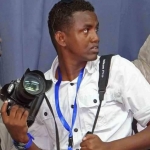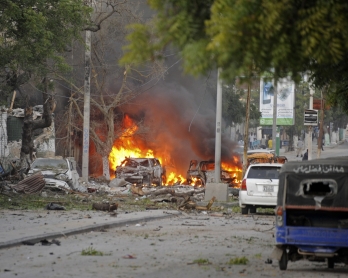Gone forever
Mogadishu -- People from abroad always ask me -- “What’s it like to live in a place like Somalia, where blasts and car bombs are a regular part of life?”
Well, let me tell you about my Saturday. It was the most interesting day yet.
You see, in Mogadishu, when you want to find out what’s happening, you don’t ask “hey, what’s happening?” you say “Is there anything interesting?” When there’s nothing, you get “It’s boring” in reply.
Saturday started out as a lovely day. I took my two sons -- five and three years old -- out of the house. My wife is pregnant and isn’t feeling well, so I wanted to give her a chance to relax. And I would get a chance to spend some time with them. The plan was to go shopping, to buy them some things. They were very excited.
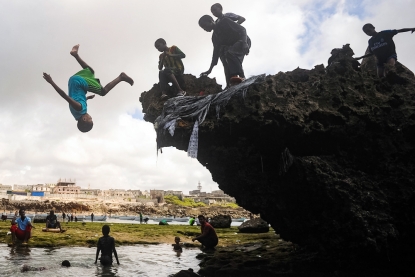 Happy children at play in Mogadishu, October 6, 2017.
(AFP / Mohamed Abdiwahab)
Happy children at play in Mogadishu, October 6, 2017.
(AFP / Mohamed Abdiwahab)We got into a tuk-tuk and headed out. We were on one of the side roads that lead to an intersection in Mogadishu that I pass every day, be it on my way to work, or to the gym, or to play football. I stop there often, to go to a store, or drink tea with my friends, or to buy peanuts from a nice lady vendor.
The traffic, as usual, was a nightmare, so we were stuck, about a kilometer away from that busy intersection.
All of the sudden, the tuk-tuk shook. So did the ground. Dust suddenly filled the air. People started to scream. Some started to run. Confusion reigned. Nobody knew what was happening. Judging by the sound -- couldn’t really see anything because of all the dust in the air -- the explosion seemed to have come from that busy intersection.
 Running from a scene of another attack, on June 1, 2016. (AFP / Mohamed Abdiwahab)
Running from a scene of another attack, on June 1, 2016. (AFP / Mohamed Abdiwahab)Since I started working as a photographer in 2009, I have covered hundreds of blasts. We get regular ones in Somalia, usually courtesy of Al-Shabab, an offshoot of Al-Qaeda that’s fighting the government. I was injured in one recently. But I’ve never been so close to one.
I grabbed my boys and we got off the tuk-tuk. They were in shock. “It’s ok, it’s ok,” I told them over and over, frantically looking around me. I had my camera with me and I had to go to the site of the blast, but what to do with them? I don’t have time to go back to my house. Then I spotted Mama Sara.
Mama Sara has a little roadside stand where I sometimes go with friends to have tea.
“Why are you coming here with your kids?” she demanded when she saw me.
“Mama Sara, please, can you keep the kids for me for a little while? I have to go to see what happened. I’ll go, take some pictures and I’ll come back.”
“All right, you go on then.”
I thanked her, kissed my bewildered and shocked kids and ran toward the blast, toward that busy intersection.
It was hard to see anything because there was so much dust in the air. It was like a fog. People were running and screaming. I took the camera out as I ran. I passed the Safari hotel next to the intersection. After I passed it, I heard gunfire coming from there. The Shebab must be trying to force their way in, I thought. That was one of their signature tactics -- first they set off a car bomb and then gunmen open fire.
Later I would learn that the security guards at the hotel had opened fire on police and soldiers who were running toward the hotel. That happens sometimes too -- there is so much confusion after a blast that nervous security personnel sometimes open fire at armed people rushing toward them. They don’t know know who they are so anyone rushing toward the place can come under fire. In this case, they didn’t kill anyone.
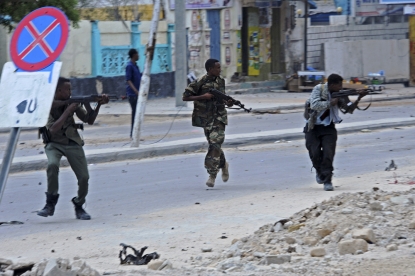 Security forces after a car bomb attack in Mogadishu on June 25, 2016. (AFP / Mohamed Abdiwahab)
Security forces after a car bomb attack in Mogadishu on June 25, 2016. (AFP / Mohamed Abdiwahab)With the gunfire behind me, I spotted a group of soldiers up ahead. The fog of dust was slowly settling. Now it was just smoke billowing up ahead. From several places.
As soon as I saw the soldiers I stopped and started walking very slowly, hanging the camera around my neck. You don’t want to be running with something in your hands past shocked soldiers after a blast. In this chaos, they can take you for the enemy, for a Shabab and you don’t want to become a target. Cameras look like guns, so it’s best to have yours hanging from your neck. So I walked by them very slowly looking directly at them. They didn’t pay any attention to me. I was in the clear. At what used to be a busy intersection that I knew so well.
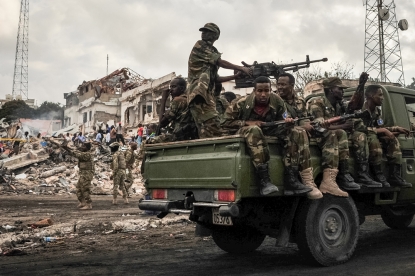 Soldiers at the scene of the blast the day after.
(AFP / Mohamed Abdiwahab)
Soldiers at the scene of the blast the day after.
(AFP / Mohamed Abdiwahab)The first victim I saw was a man with one sneaker on. He was injured in the face, by shrapnel, I suppose. There was blood all over him. “I am hurt! I am hurt!” he was screaming.
Dead bodies began coming into view all around. A person cut in half. Another without a head. Some were still alive, screaming. There was smoke everywhere -- cars were burning, buildings were burning, trucks were burning. Everything was alight. It was a busy intersection and on a Saturday afternoon it was probably jam-packed with traffic.
The smoke made it hard to breathe. I tried holding my nose and breathing with my mouth. That only made my throat scratch.
I spotted a man with a white T-shirt coming from behind a big truck that was loaded with sacks of something. It was on fire. He was very sad and walked slowly. I took a few shots of him. I tried talking to him. “Old man, what’s your name? Are you wounded? Are you ok?” He didn’t seem to hear me. He grabbed his head and looked at the sky.
“He’s dead, he’s dead,” he kept saying.
“Was he a relative?”
“Yes, yes.” And then he just walked right by me.
 (AFP / Mohamed Abdiwahab)
(AFP / Mohamed Abdiwahab)I went back to work. I tried to take photos of dead bodies, but this time it was too gruesome. Too gruesome. International media can’t use pictures like that. I still didn’t really have any pictures. I walked to the side and took some general scene shots. Then I hung the camera around my neck again and went in to help people.
In any explosion, I have to document what I see, but I also have to help people. It’s all hands on deck after a blast.
 All hands on deck to rescue victims and recover bodies after the blast on October 14, 2017. (AFP / Mohamed Abdiwahab)
All hands on deck to rescue victims and recover bodies after the blast on October 14, 2017. (AFP / Mohamed Abdiwahab)I can’t tell you how many I helped that day. Everywhere you looked people needed help -- under rubble, in burning cars, in mini buses, in big trucks. There was one minibus 300 meters away. It was on fire. Inside were kids. They were already dead. Kids! Schoolchildren. They were burnt.
Wherever I looked seemed so alien from the familiar place I had known. “This is not the place I know,” I kept thinking to myself.
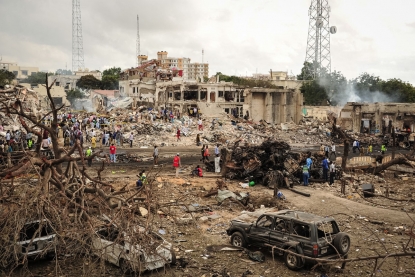 What used to be a vibrant intersection that the author passed every day. (AFP / Mohamed Abdiwahab)
What used to be a vibrant intersection that the author passed every day. (AFP / Mohamed Abdiwahab)When we have attacks in Mogadishu, you often have a second blast that goes off sometime after the first -- another signature tactic of the Shabab. That way they kill more people -- the second blast usually gets the people trying to help the victims of the first explosion. I got injured in the leg a few months back by a second blast. “Watch out for the second blast,” I usually tell myself when I work after an explosion.
But this time, I wasn’t even thinking about a second blast. The whole area was like hell already. We have a saying -- “if you’re going to hell, just go straight in.” Well, I was already deep in hell, whatever was going to happen here has already happened. I never thought that a second blast would kill me here. I kept thinking, “God, don’t let me die here, let me tell this story, let me show what has happened.”
 Victim of the attack, three days on. (AFP / Mohamed Abdiwahab)
Victim of the attack, three days on. (AFP / Mohamed Abdiwahab)After around 40 minutes, I left. The plan was to send the pictures I had, go get my kids, bring them back to my house and then come back to the scene. Except that the worst thing happened to me -- my phone went dead.
When I went back to Mama Sara’s stand, she wasn’t there. Neither were the boys. As I found out later, after I left, the boys started crying. The whole city was in turmoil, their father had disappeared and they were with an old woman they didn’t know. They have never before been left with someone they didn’t know. So Mama Sara wanted to get them out of there. She didn’t know where I lived, so she decided to take them to her house, to calm them down. There she called me to say where she was. Except that my phone was dead.
I looked around frantically Mama Sara’s roadside stand. Eventually someone told me she went back home. I headed there.
When they saw me, the younger one burst into tears. “We want Mom, We want Mom.” They kept saying. “There, there, it’s ok. We’re together now, let’s go to Mom.” Poor kids. It was supposed to be a nice day spent shopping and they ended up in the middle of chaos with an old woman they’ve never seen.
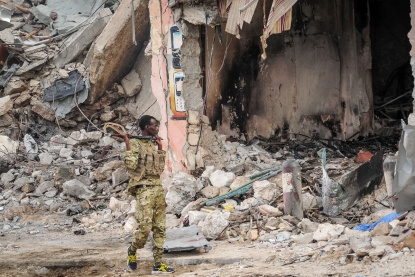 Patrolling the day after the blast. (AFP / Mohamed Abdiwahab)
Patrolling the day after the blast. (AFP / Mohamed Abdiwahab)I have seen hundreds of blasts in my eight years as a photojournalist. Little ones. Big ones. I never thought I was going to see destruction of such magnitude. At least 276 were killed and 300 injured. The government called it the “deadliest attack ever.” I don’t want to see something like this again. I haven’t slept well since. I have nightmares. My wife asks me why I don’t sleep. I don’t know, I tell her, because I don’t want to talk about it.
Everyone has been affected by this blast. Everyone either had someone killed or knows someone who has had someone killed. I have no direct of kin who died. A woman who used to be my neighbor lost her stepmother. The only thing they recovered was her hand. They identified her by the ring on it. The rest of the body was gone. Imagine that. Not only do you lose a loved one, but you can’t even bury them in one piece.
So what’s it like to live in a place like Somalia, where attacks happen so often, you ask? Well, I suppose it’s like living anywhere else. We love our families. We like to spend a day with our kids when we can. And when an attack happens, we hurt. We mourn the people lost. The fact that it happens more often here than, say, in Europe, doesn’t inure us to the pain, the loss, the suffering.
I used to go to this intersection every day. There were people there whom I saw every day. In the stores, in the cafes. The guy selling fruit. That woman I used to buy peanuts from. I will never see them again. Even after it’s rebuilt, with new cafes and vendors. These people are gone forever.
This blog was written with Yana Dlugy in Paris.
 The site of the blast in February, 2015, with federal forces patrolling the area. (Photo courtesy of Mohamed Abdiwahab)
The site of the blast in February, 2015, with federal forces patrolling the area. (Photo courtesy of Mohamed Abdiwahab)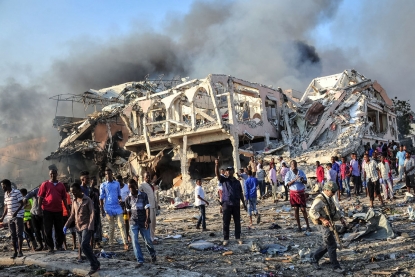 The site of the attack on Saturday, October 14, 2017.
(AFP / Mohamed Abdiwahab)
The site of the attack on Saturday, October 14, 2017.
(AFP / Mohamed Abdiwahab)


